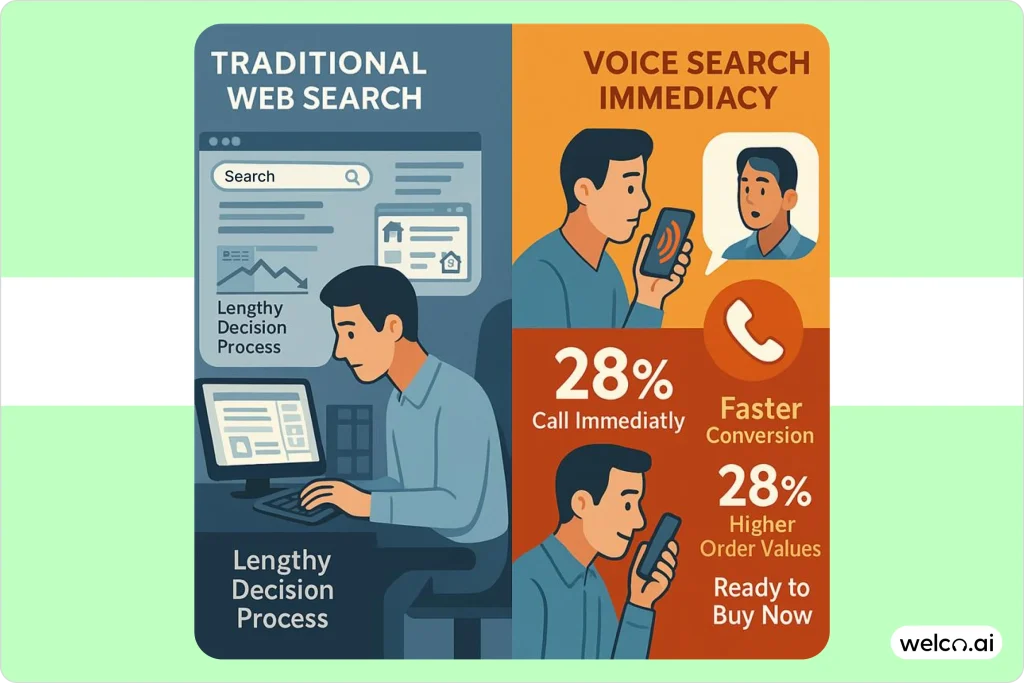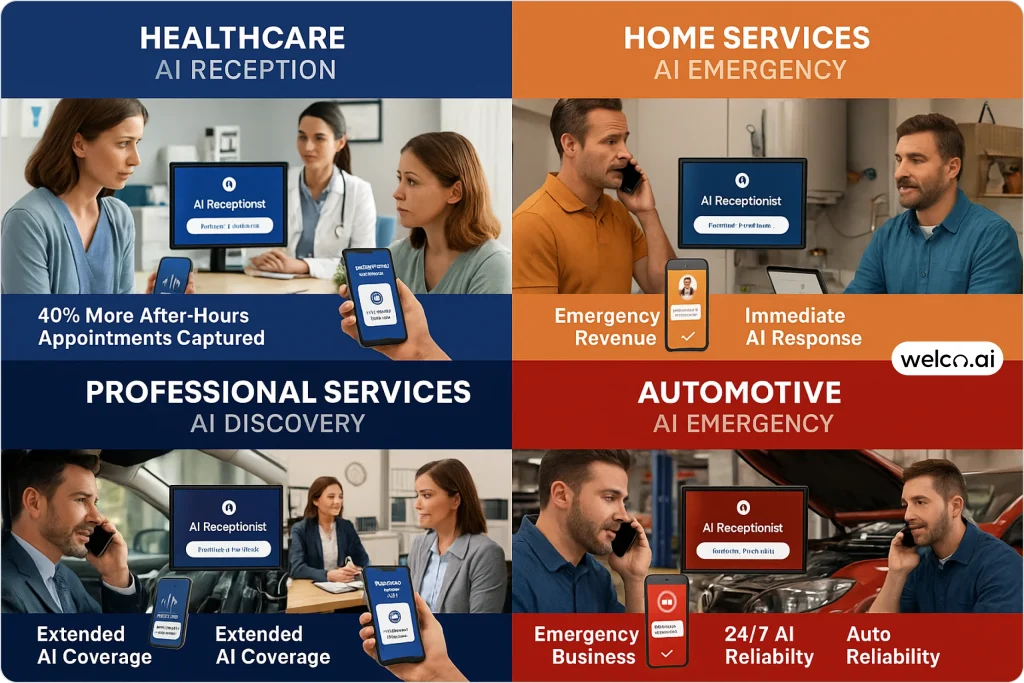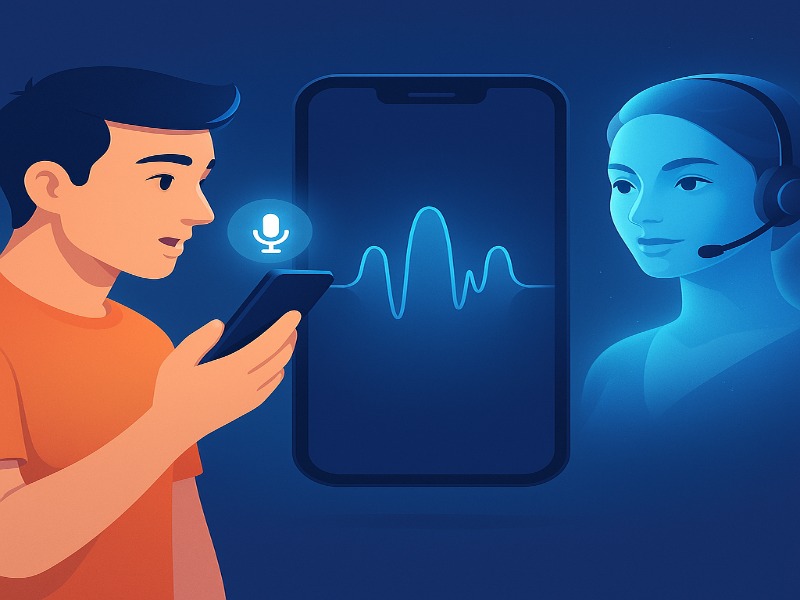Quick Assessment: Is Voice Search Affecting Your Business?
□ You notice call spikes during evening hours (6-9 PM)
□ Customers mention finding you through voice search
□ You receive calls asking for immediate service availability
□ Your Google My Business shows voice search queries
If you checked 2+, voice search is likely driving calls to your business.

The Voice Search Opportunity You’re Missing
Voice search has fundamentally changed how customers discover local businesses. According to Google, 76% of voice search users look for local businesses weekly, and 28% of these searchers call businesses immediately after finding them.
That’s nearly 3 out of 10 people who go straight from “Hey Google, find me…” to dialing your number.
But here’s the problem: most businesses aren’t prepared for this shift in customer behavior.
Why Voice Search Customers Are Gold
Voice searchers behave differently than traditional web searchers, and understanding this difference is crucial for your business.
They Have Higher Intent
Instead of typing “pizza,” voice search users say “find me the best pizza place open now near downtown.” These searches are specific and action-oriented.
They Need Help Right Now
Voice searches often happen during moments of immediate need. When someone searches for “emergency plumber,” they’re not browsing—they need help immediately.
They Convert Better and Spend More
Voice Search Gold Mine:
- 28% call immediately
- 30% faster conversion
- 28% higher order values
Voice search customers are 30% more likely to convert quickly compared to web form leads. They also have 28% higher average order values and show 25% better retention rates.
This enhanced customer value is transforming traditional approaches and accelerating the evolution of business reception toward more responsive, technology-enabled solutions.
Translation: These are the customers you want.
The Problem: Your Business Isn’t Ready
Most businesses miss out on voice search customers because they’re not optimized for the immediacy these searchers expect.
Here’s what’s happening:
- Calls go to voicemail during busy periods
- No after-hours coverage when voice searches spike
- Poor Google My Business optimization for voice queries
- No tracking to measure voice search impact
Real-World Example: The $14,400 Miss
A Phoenix roofing contractor tracked their performance during a storm damage week:
- 52 voice searches for “emergency roof repair near me”
- 14 immediate phone calls generated (27% call rate)
- 8 calls reached voicemail due to field work
- Estimated missed opportunity: $14,400 in potential revenue
Picture this: It’s 11 PM on a Wednesday, and a family discovers water dripping through their ceiling after a hailstorm. They grab their phone and say, “Hey Google, find me an emergency roofer near me.” Your competitor answers immediately while your phone goes to voicemail. Guess who gets the $1,800 repair job?

This pattern repeats across industries where immediate response matters, highlighting the importance of human-AI collaboration models that can handle high-intent customer inquiries 24/7.
How to Win Voice Search Customers
1. Optimize Your Google My Business Profile
Your Google My Business profile is your voice search storefront. Here’s how to optimize it:
Complete Every Field
- Business hours (including after-hours contact info)
- Phone number (prominently displayed)
- Services offered (use conversational language)
- Regular posts and updates
Use Natural Language Write your business description the way people speak, not the way they type. Instead of “HVAC services,” write “heating and cooling repair for homes and businesses.”
2. Create Voice Search-Friendly Content
Voice searches are typically 3-5 words longer than text searches and sound like questions.
Optimize for Questions
- “What’s the best Italian restaurant near me?”
- “Who can fix my garage door today?”
- “Where can I get my car repaired quickly?”
Build FAQ Content Create content that answers these natural voice queries. Use the exact phrases people speak.
This optimization enables voice search and business discovery capabilities that connect customers with businesses at the exact moment of need.
3. Be Available When Voice Search Peaks
Voice searches spike during specific times:
- Evening hours (6-9 PM) when people plan activities
- Weekends for immediate needs
- After business hours for emergencies
Consider extending your phone coverage during these peak times.
4. Track Your Voice Search Performance
Set up tracking to measure your voice search success:
- Monitor Google My Business insights for voice queries
- Track call volume increases from voice searches
- Measure conversion rates from voice search calls
- Calculate revenue attribution to voice search traffic
These systems often incorporate predictive service capabilities that help businesses anticipate customer needs and optimize their response strategies.
Industry-Specific Voice Search Strategies

Healthcare Practices
Voice searches often involve urgent medical needs (“find me an urgent care clinic open now”). Practices with 24/7 phone coverage capture 40% more after-hours appointments. Think about it—when someone says “find me an urgent care clinic open now,” they’re likely dealing with a sick child or an injury that can’t wait until morning. These are high-intent, high-value patients who need immediate care.
This sector particularly benefits from considering AI ethics in customer communication when implementing automated systems for sensitive health-related inquiries.
Home Services
Emergency service calls (“plumber near me right now”) represent the highest-value voice search opportunities. Picture this: It’s 8 PM on a Tuesday, and someone’s water heater just burst. They grab their phone and say, “Hey Google, find me an emergency plumber near me.” Companies with immediate phone response capture significantly more emergency revenue because voice searchers in crisis situations don’t have time to compare prices—they need help now.
Professional Services
After-hours voice searches for legal, accounting, and consulting services typically go to the first business that answers. Extended phone coverage leads to notable increases in new client acquisition. Business owners often research services during commutes or after hours when they finally have time to think about their needs. The firm that answers at 7 PM when others are closed gets the client.
These businesses often implement omnichannel integration strategies to ensure consistent customer experience across voice, phone, and digital touchpoints.
Automotive Services
Voice searches for auto repair often happen during stressful situations—breakdowns, accidents, or when the check engine light starts flashing. Someone stranded on the roadside isn’t browsing multiple options; they’re calling the first shop that picks up. Shops with reliable phone systems capture more emergency repair business because these customers are ready to tow their car wherever help is available.
Your 30-Day Voice Search Action Plan
Week 1: Assessment
- Audit your current Google My Business profile
- Review missed call patterns and timing
- Establish baseline metrics for improvement
Week 2: Optimization
- Complete your Google My Business profile
- Add FAQ content that answers voice search queries
- Optimize existing content for conversational keywords
Week 3: Implementation
- Set up call tracking to measure performance
- Extend phone coverage during peak voice search times
- Train staff on voice search customer handling
Week 4: Monitoring
- Track voice search query performance
- Measure phone conversion improvements
- Analyze initial ROI from voice search efforts
What to Expect
Timeline for Results
- Initial improvements: 2-4 weeks
- Full optimization: 60-90 days
- Clear ROI measurement: 90+ days
Investment Considerations
- Voice search optimization: Often handled in-house with existing resources
- Extended phone coverage: $200-1,000/month depending on approach
- Call tracking: $50-200/month for analytics
Common Mistakes to Avoid
Don’t assume voice search customers will wait. Unlike web visitors who browse multiple options, voice searchers expect immediate answers. If your phone goes to voicemail more than twice, they’ll call your competitor.
Don’t ignore after-hours opportunities. A significant portion of voice searches for local services happen between 6 PM and 10 AM.
Don’t optimize for keywords instead of conversations. Voice searches sound like natural speech, not typed keywords.
Getting Started Today
Immediate Actions You Can Take:
- Update your Google My Business profile with complete information
- Add your phone number prominently on all digital properties
- Create FAQ content that answers common voice search queries
- Monitor your current call patterns to identify peak times
This Week:
- Set up basic call tracking
- Research common voice search queries in your industry
- Plan extended coverage for peak voice search hours
Voice search adoption continues growing rapidly. Businesses that optimize now gain competitive advantages in capturing these high-intent, high-value customers.
The key is matching your phone infrastructure to the immediacy and intent level of voice search behavior. As these technologies evolve, we can expect to see even more sophisticated integration with future workplace virtual assistance solutions that seamlessly blend voice search discovery with intelligent customer service.
The Bottom Line: Your Competition Is Already Calling
Right now, while you’re reading this, someone in your area is saying “Hey Google, find me a [your service] near me.” They’re ready to spend money, they need help immediately, and they’re going to call the first business that appears optimized for voice search.
The opportunity is clear:
- 28% call immediately
- 30% faster conversion
- $14,400 missed in just one week (real example)
Don’t let another high-intent customer slip through to your competitor. Start optimizing for voice search today, or watch them answer the calls that should be coming to you.
Frequently Asked Questions
How do I know if voice search is driving calls to my business?
Check your Google My Business insights for voice search queries and look for patterns in call timing. Voice searches typically spike during evening hours (6-9 PM) and weekends. You can also ask callers how they found you.
What’s the difference between optimizing for voice search vs. regular SEO?
Voice search optimization focuses on conversational, long-tail keywords and question-based content. Instead of optimizing for “plumber,” you’d optimize for “find me a reliable plumber who can fix a burst pipe tonight.” Voice searches sound like natural speech.
Will voice search work for my B2B business?
Absolutely. People search for “accounting firm near me,” “business attorney downtown,” or “marketing agency for manufacturing companies.” B2B voice searches often happen during commutes or after hours when decision-makers are researching solutions.
How much should I invest in voice search optimization?
Voice search optimization can often be handled with existing resources—updating your Google My Business profile and creating FAQ content costs mainly time. The biggest investment is usually extending phone coverage, which ranges from $200-1,000/month. Most businesses see ROI within 90 days.
My business gets most calls during the day—why worry about after-hours voice search?
Voice search behavior peaks during non-business hours when people are planning ahead or dealing with emergencies. Missing these calls means losing high-intent customers to competitors who answer 24/7. Even capturing just a few after-hours voice search calls can significantly impact revenue.
